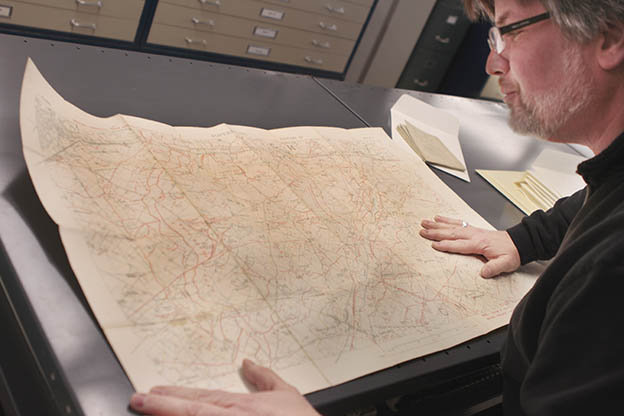Mac maps guide Toronto Star journalists across Western Front

Map specialist Gord Beck looks over a First World War trench map at McMaster's Lloyd Reeds Maps Collection. Beck is helping a pair of Toronto Star reporters navigate the Western Front using a combination of old and new technology.
While two journalists from the Toronto Star are walking the Western Front, the man in charge of McMaster’s maps is keeping the team supplied with information that helps them understand exactly what they’re seeing and what it meant 100 years ago, when war gripped the countryside of Belgium and France in a grim and costly stalemate.
Toronto Star reporter Katie Daubs and photographer Richard Lautens are spending two months walking the Western Front from the North Sea through Belgium and France, filing stories and photos, creating videos and posting Facebook and blog entries along the way.
Most of the First World War was spent with troops fighting between entrenchments, where casualties were shockingly high and survival meant tolerating disease, water, rats and poor food.
The Star’s ambitious, high-profile project is supported by information held here at McMaster’s Lloyd Reeds Maps Collection, home to an extensive and internationally significant collection of trench maps from the Great War.
Map specialist Gord Beck met with Daubs earlier this month, just before she and Lautens left for Europe.
Beck briefed the reporter on the trench maps and other McMaster resources, and he is uploading new maps for the Star team to access as they approach various landmarks along the way.
“It’s exciting. She’s sending me her itinerary every week, and I get to re-explore the collection, find what we have and upload it,” Beck says. “I’m getting a vicarious kick out of it. It’s almost like being there and walking the ground myself.”
The maps should help the journalists to interpret what they’re seeing in a landscape that has changed significantly over the last century, since years of bombardment stripped it of all recognizable features, Beck says.
Since the digital collection is available online, it attracts users from around the world, from historians and movie producers to ordinary people sitting at kitchen tables trying to visualize what it must have been like.
Many are surprised to learn that the trench systems of the First World War reached far back from the front lines in criss-cross patterns that allowed men, supplies and information to move across the battlefield, all just out of sight of their enemies.
“It blows people away when they see the spider-web networks of the trenches,” Beck says. “It still amazes me how much work had to go into this and how much work it was to support and supply these guys who were spending months in these trenches.”
While at McMaster, Daubs also reviewed wartime letters, sketches and diaries from The William Ready Division of Archives and Research Collections.

